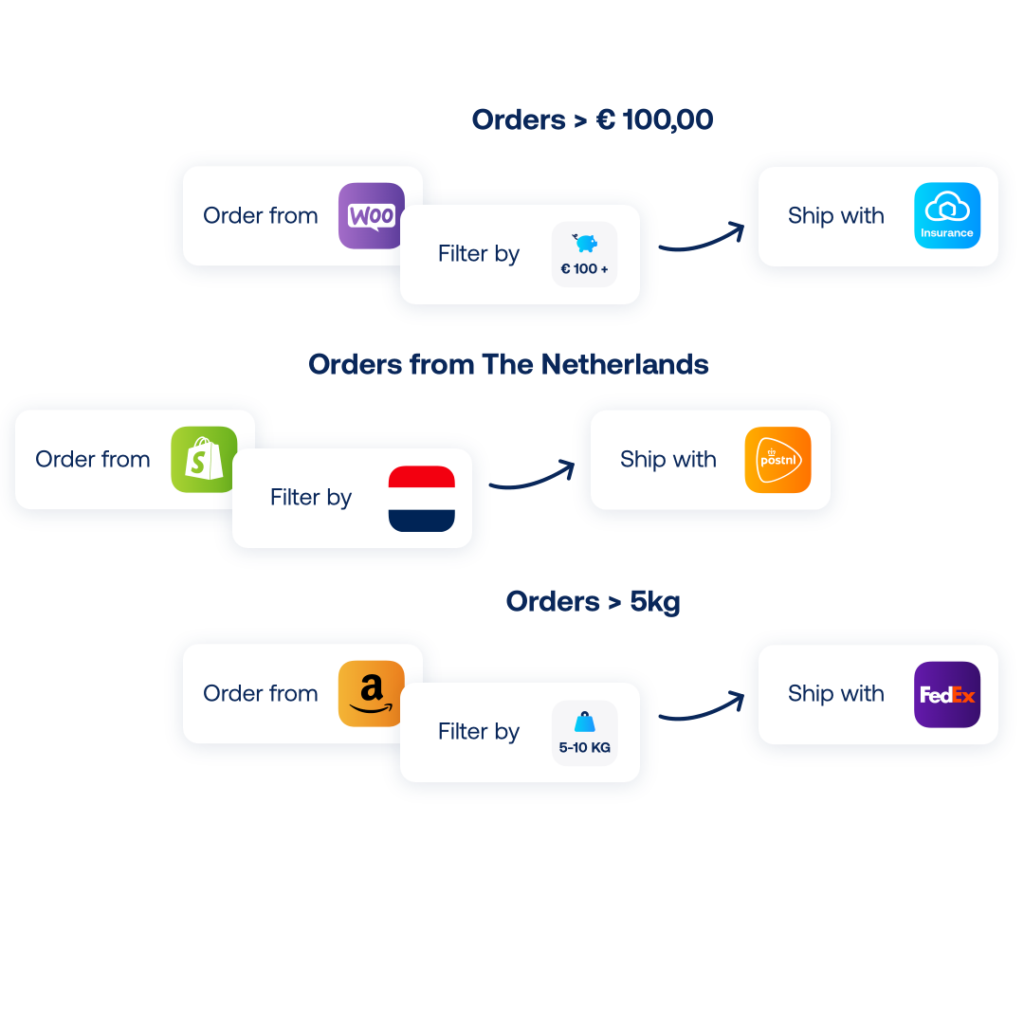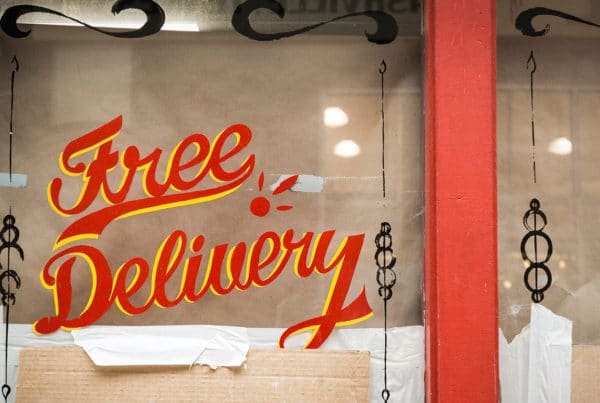What starts as a few weekly orders quickly turns into late nights printing labels, manually typing addresses, copy-pasting tracking numbers, and answering a flood of WISMO tickets. Margins get tighter. Errors creep in. And customer expectations keep rising.
The problem? Most merchants never actually build a shipping strategy, they patch workflows as they go.
But e-commerce shipping isn’t just about getting products from A to B anymore. It’s part of your brand experience, your profitability, and your ability to scale.
This guide offers a practical, 6-step playbook to turn shipping chaos into structured, customer-centric operations — without enterprise resources. You’ll learn how to assess your setup, define goals, build smart rules, and optimize with real data.
Let’s get started.
Step 1: Understand your customer’s shipping preferences
Before you overhaul your whole shipping operations, start with your customers. What they care about should shape how you deliver.
Do your shoppers prioritize speed or low cost? Do they want eco-friendly delivery, flexible pickup options, or premium unboxing? Shipping isn’t one-size-fits-all.
Market expectations also vary widely, what works in one country may backfire in another. For example: out-of-home delivery (OOH) is hugely popular in France, but can seriously hurt conversion rates in Austria. Tailor your delivery options by region — not just by default setup.
When your shipping setup doesn’t match these expectations, it leads to cart abandonment, WISMO tickets (Where is my order?), and repeat returns.
How to do it:
Don’t guess, gather insights from the sources you already have:
- Use tools like the E-commerce Delivery Compass to benchmark shopper preferences in your local market.
- Review support tickets: What are people complaining about? (Look for patterns around delivery delays or tracking issues.)
- Send a short post-purchase survey: A simple post-purchase email asking what they liked or didn’t about delivery can go a long way.
- Talk to your customer service team: They’re on the frontlines and often spot patterns before the data does.
- On-site behavior: If users drop off at checkout, it might be due to missing delivery options.
💡Example: You discover that 30% of support tickets are related to delivery delays, and most customers live in urban areas with pickup points nearby. Based on that insight, you update your checkout to offer tracked pickup delivery — lowering WISMO and improving CSAT.
Just ask By Nouck! The Dutch jewelry brand listened to their customers and cut WISMO tickets by 46% after introducing branded, proactive tracking and clearer delivery options.
Step 2: Assess your current shipping volumes and carrier setup
Once you understand what your customers want, it’s time to turn inward and evaluate how your shipping operation is really performing.
Many e-commerce brands start with one carrier and a handful of manual processes. And then keep adding patches as volume grows. The result? A messy mix of tools, portals, and workflows that drain time and invite errors.
This step is about diagnosing the leaks in your system.
How to do it:
Start with a quick internal audit:
- Order volumes: How many parcels are you shipping weekly/monthly?
- Carrier mix: Which carriers do you use? For what regions or delivery types?
- Manual processes: How much time is spent printing labels, tracking claims, managing returns?
- Error tracking: How many refunds or delays happen per month and why?
- Claims management: Are you missing refunds because of scattered communication?
Use a simple spreadsheet, or even better, apply AI. Export your support tickets and use AI tools to summarize issues by theme: carrier delays, tracking problems, label errors, etc.
This gives you a clear picture of where your workflows are breaking. Then, map it out: What happens from order to delivery? Where do things slow down or go wrong?
💡 Example: You’re working with two carriers, tracking claims manually via email. Delays go unnoticed, and missed refunds are costing you real money. After auditing, you realise you’re spending 3+ hours a week just following up on deliveries.
That’s when centralizing your carrier tracking and claims process becomes the obvious first move and frees up your team for actual growth.
XXL Nutrition did exactly that. After reducing label errors by 50%, they unlocked 40% revenue growth — just by tightening shipping operations at scale.

Step 3: Define your shipping goals
Before you start changing tools or building new workflows, get clear on what you want your shipping strategy to achieve.
Shipping isn’t just about getting parcels out the door, it’s a tradeoff between speed, cost, sustainability, customer experience, and operational control. If you don’t define your priorities, every decision becomes reactive.
How to do it:
Ask yourself:
- What matters most to our brand and customers?
- Fast delivery, or lower cost?
- Eco options, or maximum flexibility?
- White-glove experience, or streamlined ops?
- Where do we ship? Local vs international shipping requires different setups.
- What’s our product type and margin? Heavy, fragile, or high-ticket items may need more robust shipping logic.
- What’s our brand promise? If you sell premium, your delivery experience needs to match.
Use your answers to map out clear shipping goals. These become your north star when deciding between carriers, service levels, and tools.
Match your goals to shipping tradeoffs
| Goal | What it impacts | Potential tradeoffs |
|---|---|---|
| Fast delivery | Conversion rate, satisfaction | Higher cost, carrier limits |
| Low cost | Margins, international expansion | Slower delivery, fewer options |
| Sustainability | Brand perception, loyalty | May increase delivery time |
| Premium experience | NPS, reviews, repeat business | More setup, branded packaging |
| Operational control | Team efficiency, error rate | Requires rules or automation |
→ Use this as a gut check. If multiple goals are important, prioritize — or balance them with rules.
💡 Example: Let’s say you want to focus on sustainability and customer loyalty. You choose slower, eco-friendly delivery options and use proactive tracking to keep customers in the loop. Your NPS goes up — not down — because the experience feels intentional and aligned with your brand.
Shipping goals don’t need to be fast or cheap. They just need to be clear.
Step 4: Build your shipping rules
This is where your strategy turns into structure.
Shipping rules help automate decisions, reduce errors, and create consistency, without needing complex tools from day one. They’re the “if-this-then-that” logic that makes your shipping smarter and more scalable.
Think of rules as invisible assistants keeping your checkout, fulfillment, and post-purchase experience aligned with your goals.
How to do it:
Start with simple, high-impact rules:
- Checkout delivery options: e.g., free shipping over €75, pickup point for urban customers
- Fallback carriers: e.g., if DHL delay >48h, switch to DPD
- Auto-insure high-value goods: e.g., automatically add insurance for items over €150 to avoid manual claims later
- Returns logic: e.g., auto-approve return requests under €30
- Customer comms: e.g., send branded tracking emails at key moments (label created, in transit, delivered)
These rules reduce manual decisions, improve customer experience, and free up your team’s time. Write them down. Even if you’re not automating them yet.
The result? Lower refund rates and fewer WISMO tickets, because customers get a consistent, predictable experience.
That’s what Boots NL did. With smart carrier rules in place, they increased shipped parcels by 58%, while improving delivery reliability.
Step 5: Automate with the right tools (when you’re ready)
Shipping tools are powerful — but they’re not a silver bullet. Integration should come after you’ve clarified your goals and built foundational rules. Otherwise, you risk automating chaos.
The right time to bring in automation is when volume or complexity makes manual processes unsustainable. That’s when tools start saving you real time and money.
How to do it:
Look for areas where manual work is slowing you down:
- Are you printing labels one by one?
- Copy-pasting tracking codes into emails?
- Logging into multiple carrier portals daily?
- Manually updating customers about delays?
When these tasks start eating hours per week, it’s time to connect your webshop, shipping platform, customer service tools, and carrier — and then use those integrations to automate repetitive work.
Focus your first automations on:
- Label creation: auto-generate and print
- Shipping rules: apply logic automatically at checkout
- Tracking updates: sync status with branded emails
- Claims & returns: centralize and automate
💡 Example: You’re shipping 150+ parcels a week and still printing labels manually and emailing tracking info one by one. After connecting your webshop and shipping platform, you automate label generation and branded tracking emails. Suddenly, fulfillment takes minutes, and customers get a smooth experience without extra work from your team.
That’s how WoodWatch scaled to 100+ countries and saved 50% in personnel time — by automating their shipping workflows.
Not sure which tools are right for your business? We’ve broken down the best e-commerce shipping tools here.
Step 6: Monitor, optimize, and iterate
Shipping isn’t “set and forget.” Once your strategy is live, your real job begins: making it better.
Customer needs evolve. Carrier performance changes. Small inefficiencies, if left unchecked, can quietly erode margins or customer satisfaction. The most successful merchants continuously monitor performance and tweak their strategy.
How to do it:
Start by identifying the metrics that reflect your shipping performance:
- Shipping cost per order
- Error rate (wrong labels, failed deliveries)
- WISMO tickets
- Return rate
- Refund success rate
- Carrier performance (on-time delivery, claims resolution)
- Exception monitoring (missed pickups, lost parcels)
- Customer reviews: Track Trustpilot and other review platforms for recurring themes related to delivery: delays, poor packaging, or lack of updates can show up here before they show in your data.
Then set a review cadence, we suggest doing so monthly. Use reports from your shipping platform or create a simple dashboard to spot trends and bottlenecks.
Run small experiments:
- Test a new carrier for specific zones
- Try branded tracking vs plain emails
- Adjust return policies for high-risk products
💡 Example: You notice WISMO tickets have spiked, despite no major carrier issues. After digging into your tracking flow, you realize one update email was removed during a recent template change. You reinstate it, and support tickets drop within days.
Smart merchants don’t wait for issues to pile up. They catch them early, and use data to grow smarter.
Common shipping strategy challenges (and how to work around them)
Even with a clear shipping strategy, growing teams face hurdles. The key isn’t to avoid them. It’s to plan for them.
Here are the most common sticking points for growing e-com brands, and how to move past them:
| Challenge | What to do instead |
|---|---|
| 🚫 Budget constraints | Start with rules, not tools. Manual processes can still follow smart logic. Then, scale automation step by step as volume and confidence grow. |
| 🤯 Fear of complexity | Keep it simple. Focus on high-impact fixes first (like tracking emails or return flows). Layer on tools later. |
| 🕵️♂️ No one owns shipping | Assign clear ownership. Even if it’s a small team, someone needs to own and evolve the shipping setup over time. |
| 🌍 Cross-border confusion | Start with transparency. Set clear delivery expectations and offer simplified returns for international customers. |
Conclusion: Structure beats size in e-commerce shipping
Shipping might feel like the most chaotic part of your business — but it doesn’t have to be.
By following this 6-step strategy, you go from reactive workflows to structured operations that scale. You understand your customers, optimize your setup, define clear goals, and automate where it matters. And most importantly, you build a delivery experience that supports growth, not blocks it.
This is what Connected Shipping looks like in action. It’s not a theory. It’s a mindset and this framework is how you bring it to life. From checkout to tracking to returns, your shipping becomes part of your brand experience. And that’s how small merchants start competing with the big players.
You don’t need enterprise tools to act like an enterprise. You just need the right strategy and the right partner.
Ready to put this strategy into action? The next step is choosing the tools to power it. Read the top e-commerce shipping tools.
Already feeling the shipping squeeze?
See how Sendcloud helps growing merchants automate operations, reduce errors, and deliver a standout customer experience — without enterprise complexity. Explore how Sendcloud works.
















